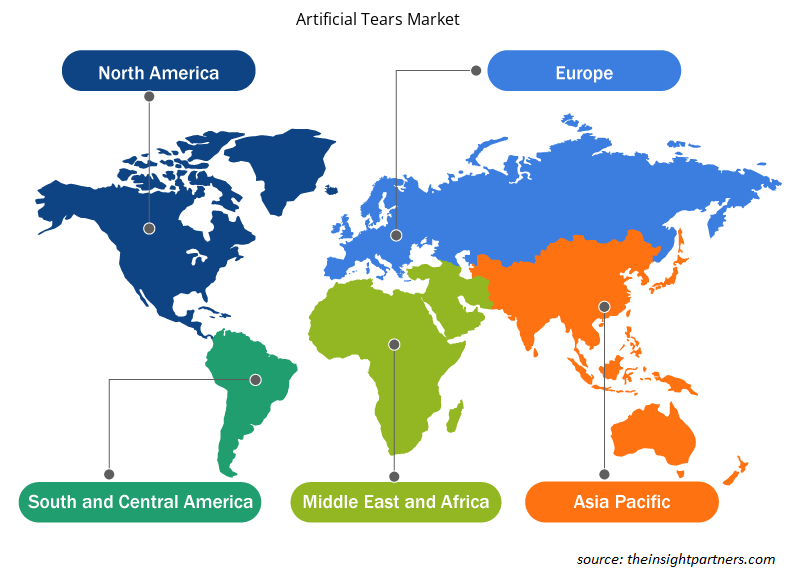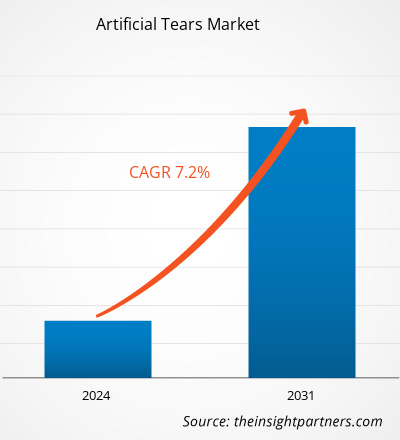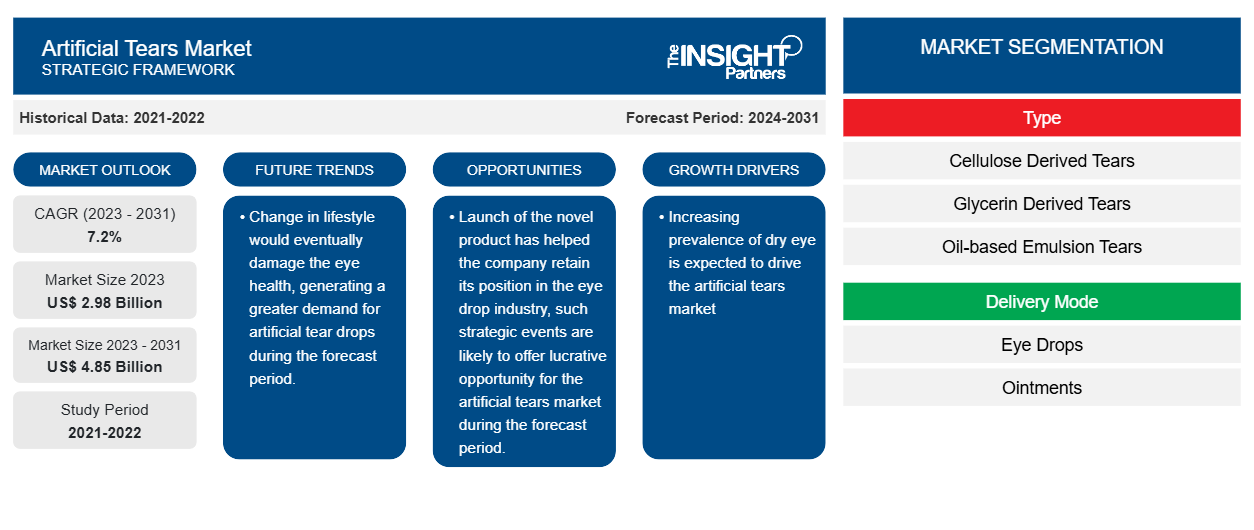Si prevede che la dimensione del mercato delle lacrime artificiali raggiungerà i 4,85 miliardi di dollari entro il 2031, rispetto ai 2,98 miliardi di dollari del 2023. Si prevede che il mercato registrerà un CAGR del 7,2% nel periodo 2023-2031. I cambiamenti nello stile di vita rimarranno probabilmente una tendenza chiave nel mercato.CAGR of 7.2% during 2023–2031. Lifestyle changes will likely remain a key trend in the market.
Analisi di mercato delle lacrime artificiali
L'incidenza crescente dell'occhio secco e l'invecchiamento della popolazione sono i principali fattori trainanti dello sviluppo del mercato. Inoltre, il crescente numero di sviluppi industriali rappresenta un'opportunità cruciale per gli operatori del mercato delle lacrime artificiali.
Panoramica del mercato delle lacrime artificiali
L'incidenza dell'occhio secco è in aumento tra la popolazione, soprattutto nelle nazioni sviluppate. L'occhio secco è causato da molteplici fattori che provocano disagio, irritazione e disturbi visivi. Ad esempio, secondo uno studio "National Health and Wellness Survey" condotto negli Stati Uniti nell'aprile 2020, circa 16,4 milioni di persone hanno ricevuto una diagnosi di occhio secco. I dati hanno anche affermato che la prevalenza è aumentata del 2,7% tra le persone di età compresa tra 18 e 34 anni. Inoltre, la prevalenza era del 18,6% tra le persone anziane. In base al sesso, la percentuale di prevalenza era più alta nelle donne; rappresentava l'8,8% rispetto agli uomini con il 4,5%. L'incidenza dell'occhio secco è più alta tra le popolazioni europee e dell'Asia Pacifica. Pertanto, si prevede che la crescente prevalenza dell'occhio secco guiderà il mercato delle lacrime artificiali.
Personalizza questo report in base alle tue esigenze
Riceverai la personalizzazione gratuita di qualsiasi report, comprese parti di questo report, o analisi a livello nazionale, pacchetto dati Excel, oltre a usufruire di grandi offerte e sconti per start-up e università
-
Scopri le principali tendenze di mercato in questo rapporto.Questo campione GRATUITO includerà analisi di dati che spaziano dalle tendenze di mercato alle stime e alle previsioni.
Driver e opportunità del mercato delle lacrime artificiali
Invecchiamento della popolazione
L'incidenza dell'occhio secco è comunemente riscontrata nelle persone di età pari o superiore a 65 anni. La popolazione geriatrica sta aumentando rapidamente in tutto il mondo. Secondo la revisione del 2019 di World Population Prospects, entro il 2050, una persona su sei avrà più di 65 anni, un aumento rispetto a una su undici nel 2019. Inoltre, secondo lo stesso studio, si stima che una persona su quattro in Europa e Nord America avrà più di 65 anni entro il 2050. Inoltre, le persone con più di 80 anni raggiungeranno i 426 milioni entro il 2050, rispetto ai 143 milioni del 2019. L'invecchiamento è uno dei fattori principali che indebolisce la vista. Diverse aziende sanitarie progettano i loro prodotti concentrandosi sulla popolazione geriatrica. Il processo di degenerazione delle persone anziane è molto più rapido, quindi sono altamente inclini a patologie oculari. Pertanto, l'elevata prevalenza dell'occhio secco tra la popolazione anziana probabilmente incoraggerà i produttori a introdurre nuovi prodotti per gli occhi, che, a loro volta, contribuiranno alla crescita del mercato. Inoltre, lo sviluppo nel settore sanitario ha aumentato l'aspettativa di vita. I paesi in tutto il mondo stanno adottando nuove tecniche per curare le persone anziane in modo sicuro ed efficace. Pertanto, l'aumento della qualità della vita sta riducendo i tassi di mortalità e la popolazione anziana sta crescendo significativamente in tutto il mondo. Si prevede che ciò stimolerà la crescita del mercato.
Numero crescente di sviluppi industriali
Il settore sta assistendo a molte attività commerciali che stanno generando un'opportunità di crescita molto redditizia per il mercato. Gli attori del settore si stanno concentrando sulle strutture di marca e sul consolidamento dei canali di distribuzione della supply chain per sfruttare la loro presenza nel mercato globale. Ad esempio, a marzo 2020, Grafton Optical ha lanciato I-DROP MGD Viscoadaptive Tears che alleviano l'occhio secco evaporativo cronico grave. I-DROP MGD è una lacrima artificiale senza conservanti che aiuta ad alleviare i sintomi associati all'occhio secco evaporativo per i pazienti affetti da disfunzione delle ghiandole di Meibomio. È il collirio più avanzato per idratare e lubrificare la cornea. Inoltre, le aziende stanno lavorando in modo proattivo per lanciare prodotti avanzati sul mercato. Ad esempio, a marzo 2020, Alcon, leader mondiale nella cura degli occhi, ha introdotto SYSTANE HYDRATION Preservative-Free (PF) Lubricant Eye Drops per l'occhio secco. Viene utilizzato per alleviare la secchezza oculare e proteggere da ulteriori irritazioni.MGD Viscoadaptive Tears that relieve severe chronic evaporative dry eye. I-DROP MGD is a preservative-free, artificial tear that helps relieve symptoms associated with evaporative dry eye for patients suffering from Meibomian Gland Dysfunction. It is the most advanced Alcon, the global leader in eye care, introduced SYSTANE HYDRATION Preservative-Free (PF) Lubricant Eye Drops for dry eye. It is used to relieve eye dryness and protect against further irritation.
Inoltre, nell'ottobre 2019, Allergan ha lanciato una nuova linea di prodotti chiamata Refresh Relieva Lubricant Eye. Il lancio del nuovo prodotto ha aiutato l'azienda a mantenere la sua posizione nel settore dei colliri. Tali eventi strategici offriranno probabilmente opportunità di crescita redditizie per il mercato delle lacrime artificiali durante il periodo di previsione.Allergan launched a new product line called Refresh Relieva lubricant eye. Launching the novel product has helped the company retain its position in the eye drop industry. Such strategic events will likely offer lucrative growth opportunities for the artificial tears market during the forecast period.
Analisi della segmentazione del rapporto di mercato delle lacrime artificiali
I segmenti chiave che hanno contribuito alla derivazione dell'analisi di mercato delle lacrime artificiali sono tipologia, consegna e applicazione.
- In base al tipo, il mercato delle lacrime artificiali è segmentato in lacrime derivate dalla cellulosa, lacrime derivate dalla glicerina, lacrime in emulsione a base di olio, lacrime a base di polietilenglicole, lacrime a base di glicole propilenico, lacrime artificiali a base di ialuronato di sodio. Il segmento delle lacrime derivate dalla glicerina ha detenuto una quota di mercato più significativa nel 2023.polythylene glycol based tears, propylene glycol based tears, sodium hyaluronate based artificial tears. The glycerin derived tears segment held a most significant market share in 2023.
- In base alla modalità di erogazione, il mercato delle lacrime artificiali è segmentato in colliri e unguenti. Il segmento delle lacrime derivate dalla glicerina ha detenuto la quota di mercato più significativa nel 2023.
- In base all'applicazione, il mercato delle lacrime artificiali è segmentato in trattamento per occhi secchi, idratazione delle lenti a contatto. Il segmento del trattamento per occhi secchi ha detenuto la quota di mercato maggiore nel 2023.
Analisi della quota di mercato delle lacrime artificiali per area geografica
L'ambito geografico del rapporto sul mercato delle lacrime artificiali è suddiviso principalmente in cinque regioni: Nord America, Asia Pacifico, Europa, Medio Oriente e Africa, e Sud e Centro America.
In Nord America, il mercato statunitense delle lacrime artificiali detiene la quota maggiore della regione. Gli Stati Uniti sono il paese più grande e in più rapida crescita nella regione nordamericana per il mercato delle lacrime artificiali. Si prevede che il mercato crescerà a causa dell'aumento dell'incidenza di condizioni o malattie dell'occhio secco. Il paese ha diverse aziende che offrono diversi tipi di colliri e lenti per trattare le condizioni dell'occhio secco. Inoltre, la crescente spesa sanitaria sta influenzando la crescita del mercato del paese. Secondo i dati dell'American Academy of Ophthalmology per il 2019, nel 2012 la prevalenza delle condizioni dell'occhio secco è aumentata del 5,28% in tutte le fasce d'età. La percentuale per le donne è aumentata del 7,78%; negli uomini, è aumentata del 2,96%.
A causa della crescente percentuale di persone con occhio secco, è previsto un aumento della domanda di prodotti a base di lacrime artificiali. Inoltre, la spesa sanitaria per il trattamento dell'occhio secco sta aumentando nel paese. Ad esempio, un articolo pubblicato su JAMA Internal Medicine afferma che il governo spende più di 2 miliardi di dollari all'anno per curare le condizioni dell'occhio secco.JAMA Internal Medicine states that the government spends more than US$ 2 billion yearly to treat dry eye conditions.
Approfondimenti regionali sul mercato delle lacrime artificiali
Le tendenze regionali e i fattori che influenzano il mercato delle lacrime artificiali durante il periodo di previsione sono stati ampiamente spiegati dagli analisti di Insight Partners. Questa sezione discute anche i segmenti e la geografia del mercato delle lacrime artificiali in Nord America, Europa, Asia Pacifico, Medio Oriente e Africa e Sud e Centro America.

- Ottieni i dati specifici regionali per il mercato delle lacrime artificiali
Ambito del rapporto di mercato sulle lacrime artificiali
| Attributo del report | Dettagli |
|---|---|
| Dimensioni del mercato nel 2023 | 2,98 miliardi di dollari USA |
| Dimensioni del mercato entro il 2031 | 4,85 miliardi di dollari USA |
| CAGR globale (2023-2031) | 7,2% |
| Dati storici | 2021-2022 |
| Periodo di previsione | 2024-2031 |
| Segmenti coperti |
Per tipo
|
| Regioni e Paesi coperti |
America del Nord
|
| Leader di mercato e profili aziendali chiave |
|
Densità dei player del mercato delle lacrime artificiali: comprendere il suo impatto sulle dinamiche aziendali
Il mercato delle lacrime artificiali sta crescendo rapidamente, spinto dalla crescente domanda degli utenti finali dovuta a fattori quali l'evoluzione delle preferenze dei consumatori, i progressi tecnologici e una maggiore consapevolezza dei benefici del prodotto. Con l'aumento della domanda, le aziende stanno ampliando le loro offerte, innovando per soddisfare le esigenze dei consumatori e capitalizzando sulle tendenze emergenti, il che alimenta ulteriormente la crescita del mercato.
La densità degli operatori di mercato si riferisce alla distribuzione di aziende o società che operano in un particolare mercato o settore. Indica quanti concorrenti (operatori di mercato) sono presenti in un dato spazio di mercato in relazione alle sue dimensioni o al valore di mercato totale.
Le principali aziende che operano nel mercato delle lacrime artificiali sono:
- Servizi Johnson, Inc.
- Alcon Inc.
- OASIS Medico
- AbbVie Inc.
- Società per azioni Bayer
- Prestige Consumer Healthcare Inc.
Disclaimer : le aziende elencate sopra non sono classificate secondo un ordine particolare.

- Ottieni una panoramica dei principali attori del mercato delle lacrime artificiali
Notizie e sviluppi recenti sul mercato delle lacrime artificiali
Il mercato delle lacrime artificiali viene valutato raccogliendo dati qualitativi e quantitativi dopo la ricerca primaria e secondaria, che include importanti pubblicazioni aziendali, dati associativi e database. Di seguito sono elencati alcuni degli sviluppi nel mercato delle lacrime artificiali:
- Sun Pharma ha lanciato la sua terapia oftalmologica specialistica CEQUA in India per curare i pazienti affetti da sindrome dell'occhio secco (DED). (Fonte: Sun Pharma., sito Web aziendale, aprile 2023)
Copertura e risultati del rapporto sul mercato delle lacrime artificiali
Il rapporto "Dimensioni e previsioni del mercato delle lacrime artificiali (2021-2031)" fornisce un'analisi dettagliata del mercato che copre le seguenti aree:
- Dimensioni e previsioni del mercato della nutrizione parenterale a livello globale, regionale e nazionale per tutti i principali segmenti di mercato coperti dall'ambito
- Tendenze del mercato della nutrizione parenterale e dinamiche di mercato come fattori trainanti, limitazioni e opportunità chiave
- Analisi dettagliata delle cinque forze PEST/Porter e SWOT
- Analisi di mercato della nutrizione parenterale che copre le principali tendenze del mercato, il quadro globale e regionale, i principali attori, le normative e i recenti sviluppi del mercato.
- Analisi del panorama industriale e della concorrenza che copre la concentrazione del mercato, l'analisi della mappa di calore, i principali attori e gli sviluppi recenti per il mercato delle lacrime artificiali
- Profili aziendali dettagliati
- Analisi storica (2 anni), anno base, previsione (7 anni) con CAGR
- Analisi PEST e SWOT
- Valore/volume delle dimensioni del mercato - Globale, Regionale, Nazionale
- Industria e panorama competitivo
- Set di dati Excel
Report recenti
Testimonianze
Motivo dell'acquisto
- Processo decisionale informato
- Comprensione delle dinamiche di mercato
- Analisi competitiva
- Analisi dei clienti
- Previsioni di mercato
- Mitigazione del rischio
- Pianificazione strategica
- Giustificazione degli investimenti
- Identificazione dei mercati emergenti
- Miglioramento delle strategie di marketing
- Aumento dell'efficienza operativa
- Allineamento alle tendenze normative























 Ottieni un campione gratuito per - Mercato delle lacrime artificiali
Ottieni un campione gratuito per - Mercato delle lacrime artificiali